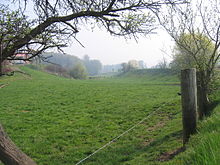Siek (lowland)
Siek generally refers to a damp lowland.
In particular, certain typical cultural landscape elements in eastern Westphalia , especially in Lippe and in the Ravensberger Land , are referred to as Sieke . In East Westphalia , “Siek” is therefore a very common component of field, street, place and proper names, for example “Heidsiek”, “Siekhorst”, “Im Siek”, “Siekmann”, “ Sieker ” etc.
Emergence
The fertile loess soils here are mostly criss-crossed by a multitude of streams and spring rivulets that used to flow in swampy crenal valleys . Sieke are and were not always crossed by a stream, but at least always moist to the ground. In the course of medieval and early modern culture and cultivation history, man intervened in these natural formations in such a way that he transformed the notch valleys into trough and box valleys and the streams that might be present by tapping the edges (the so-called "meadow breaking" by Wiskenmaker ) regulated so that they flowed in straight beds on the edge of such a box valley. The aim of this measure was, on the one hand, the creation of moist grassland in the now broad and accessible stream meadows, which could then be extensively managed. Secondly, the torn grass plugs were used to fertilize the surrounding fields ( pest fertilization ). In the Ravensberger Land, sieves are therefore mostly narrow trough valleys that cut into the landscape immediately and that lie next to arable knolls ( Plaggenesche ) that have been additionally increased by the pest fertilization.
Meaning today
Since the grassland areas in the sieves have largely become economically superfluous due to the changed production conditions in modern agriculture, many unused sieves would become boggy again in the long run without mowing and care and turn into black alder quarries , for example . The task of nature conservation and cultivated landscape maintenance today is to ensure a balanced relationship between renaturing silts on the one hand and regularly mowed grasslands on the other. Examples of protected sieving systems are the Kilverbachtal ⊙ and the Wöhrener Siek in the Ravensberger Land.
Siepen
Etymologically possibly related or conceptually similar is the valley shape " Siepen ", which can be found mainly in the South Westphalian region and generally also describes bottom-wet valleys, but mostly water-bearing V-valleys.
literature
- Florian Herzig: On the value of the damp meadows, creation, use and destruction of the Sieke in the Ravensberg hill country . In: Kreisheimatverein Herford (Hrsg.), Kommunalarchiv Herford (Hrsg.): Historisches Jahrbuch für die Kreis Herford 2005 . Publishing house for regional history. Bielefeld 2004. ISBN 389534592X
Individual evidence
- ^ Adolf Schüttler: The Ravensberger Land . Aschendorff, Münster 1995, p. 13, ISBN 3-402-06348-4

